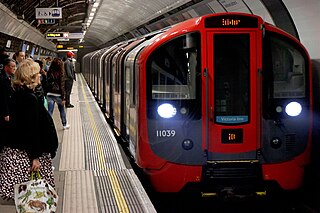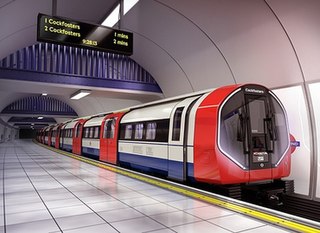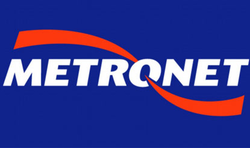
Transport for London (TfL) is a local government body responsible for most of the transport network in London, United Kingdom.

The Waterloo & City line, colloquially known as The Drain, is a London Underground shuttle line that runs between Waterloo and Bank with no intermediate stops. Its primary traffic consists of commuters from south-west London, Surrey and Hampshire arriving at Waterloo main line station and travelling forward to the City of London financial district. For this reason, the line has historically not operated on Sundays or public holidays, except in very limited circumstances. Following the COVID-19 pandemic, the line is currently only open on weekdays. It is one of only two lines on the Underground network to run completely underground, the other being the Victoria line.

The Central line is a London Underground line that runs through central London, from Epping, Essex, in the north-east to Ealing Broadway and West Ruislip in west London. Printed in red on the Tube map, the line serves 49 stations over 46 miles (74 km), making it the longest line on the Underground. It is one of only two lines on the Underground network to cross the Greater London boundary, the other being the Metropolitan line. One of London's deep-level railways, Central line trains are smaller than those on British main lines.

The Bakerloo line is a London Underground line that runs from Harrow & Wealdstone in suburban north-west London to Elephant & Castle in south London, via the West End. Printed in brown on the Tube map, it serves 25 stations, 15 of which are underground, over 23.2 kilometres (14.4 mi). It runs partly on the surface and partly through deep-level tube tunnels.

The Circle line is a spiral-shaped London Underground line, running from Hammersmith in the west to Edgware Road and then looping around central London back to Edgware Road. The railway is below ground in the central section and on the loop east of Paddington. Unlike London's deep-level lines, the Circle line tunnels are just below the surface and are of similar size to those on British main lines. Printed in yellow on the Tube map, the 17-mile (27 km) line serves 36 stations, including most of London's main line termini. Almost all of the route, and all the stations, are shared with one or more of the three other sub-surface lines, namely the District, Hammersmith & City and Metropolitan lines. On the Circle and Hammersmith & City lines combined, over 141 million passenger journeys were recorded in 2019.

The Hammersmith & City line is a London Underground line that runs between Hammersmith in west London and Barking in east London. Coloured pink on the Tube map, it serves 29 stations over 15.8 miles (25.5 km). Between Farringdon and Aldgate East it skirts the City of London, the capital's financial heart, hence the line's name. Its tunnels are just below the surface and are a similar size to those on British main lines. Most of the track and all stations are shared with either the District, Circle, or Metropolitan lines. Over 141 million passenger journeys are made each year on the Hammersmith & City and Circle lines.

Mile End is a London Underground station in Mile End, London. It is served by the Hammersmith & City, District and Central lines. This station features a cross-platform interchange in both directions; District and Hammersmith & City lines stop on the inside tracks, and the Central line stops on the outside tracks. It is in Travelcard Zone 2.
Robert R. Kiley was an American public transit planner and supervisor, with a reputation of being able to save transit systems experiencing serious problems. From 2001 to 2006 he was the initial Commissioner of Transport for London, the public organisation empowered with running and maintaining London's public transport network.

The London Underground 1992 Stock is a type of rolling stock used on the Central and Waterloo & City lines of the London Underground. A total of 85 eight-car trains were built for the Central line and 5 four-car trains were built for the Waterloo & City line.

The history of the London Underground began in the 19th century with the construction of the Metropolitan Railway, the world's first underground railway. The Metropolitan Railway, which opened in 1863 using gas-lit wooden carriages hauled by steam locomotives, worked with the District Railway to complete London's Circle line in 1884. Both railways expanded, the Metropolitan eventually extending as far as Verney Junction in Buckinghamshire, more than 50 miles (80 km) from Baker Street and the centre of London. The first deep-level tube line, the City and South London Railway, opened in 1890 with electric trains. This was followed by the Waterloo & City Railway in 1898, the Central London Railway in 1900, and the Great Northern and City Railway in 1904. The Underground Electric Railways Company of London (UERL) was established in 1902 to fund the electrification of the District Railway and to complete and operate three tube lines, the Baker Street and Waterloo Railway, the Charing Cross, Euston and Hampstead Railway and the Great Northern, Piccadilly and Brompton Railway, which opened in 1906–07. By 1907 the District and Metropolitan Railways had electrified the underground sections of their lines.

Tube Lines Limited, initially known as Infraco JNP, was an asset-management company responsible for the maintenance, renewal and upgrade of the infrastructure, including track, trains, signals, civils work and stations, of three London Underground lines.

The London Underground 1972 Stock is a type of rolling stock used on the London Underground. The 1972 Stock was originally ordered to make up the shortfall in trains on the Northern line's 1959 Tube Stock fleet, but is currently used on the Bakerloo line. Following the withdrawal of the British Rail Class 483 EMUs in 2021, the 1972 Stock are now the oldest EMUs in passenger service in the United Kingdom. A total of 63 seven-car trains were built in two separate batches.

The London Underground 2009 Stock is a type of London Underground train built by Bombardier as part of its Movia family at its Derby Litchurch Lane Works, England. A total of 47 eight-car trains have been built for the Victoria line. They entered service between July 2009 and June 2011 and replaced the 1967 Tube Stock. It is the first new deep level tube stock on the Underground network since the 1996 Stock entered service on the Jubilee line in 1997.

The London Underground S7 and S8 Stock, commonly referred to as S Stock, is a type of passenger train running on the London Underground's subsurface lines since 2010. Manufactured by Bombardier Transportation's Derby Litchurch Lane Works, the S Stock was ordered to replace the A60, A62, C69, C77 and D78 stock on the Metropolitan, District, Hammersmith & City, and Circle lines, which all dated from the 1960s and 1970s.

Amey plc, previously known as Amey Ltd and Amey Roadstone Construction, is a United Kingdom-based infrastructure support service provider.
The Old Dalby Test Track is a railway in the United Kingdom which is used for testing new designs of trains and railway infrastructure. It runs between Melton Mowbray, Leicestershire and Edwalton, on the course of the Midland Railway's route between Kettering and Nottingham which closed to passengers on 1 May 1967, and to goods in 1968. It is 13.5 miles (21.7 km) in length.

The history of the District line started in 1864 when the Metropolitan District Railway was created to create an underground 'inner circle' connecting London's railway termini. The first part of the line opened using Metropolitan Railway gas-lit wooden carriages hauled by steam locomotives. The District introduced its own trains in 1871 and was soon extended westwards through Earl's Court to Fulham, Richmond, Ealing and Hounslow. After completing the 'inner circle' and reaching Whitechapel in 1884, it was extended to Upminster in East London in 1902. To finance electrification at the beginning of the 20th century, American financier Charles Yerkes took it over and made it part of his Underground Electric Railways Company of London (UERL) group. Electric propulsion was introduced in 1905, and by the end of the year electric multiple units operated all of the services.

The London Underground 2024 Stock, known as the New Tube for London (NTfL) during development, is a London Underground train being built by Siemens Mobility at its facilities in Goole, United Kingdom and Vienna, Austria. It is part of the Siemens Inspiro family of metro and rapid-transport trains.

Sir Malcolm Rowland Bates was a British industrialist. He served as the chairman of London Regional Transport from 1999 to 2003.
The Four Lines Modernisation (4LM) is a series of projects by Transport for London (TfL) to modernise and upgrade the sub-surface lines of the London Underground: the Circle, District, Hammersmith & City and Metropolitan lines. The upgrades entail new rolling stock, new signalling and new track and drainage.

















